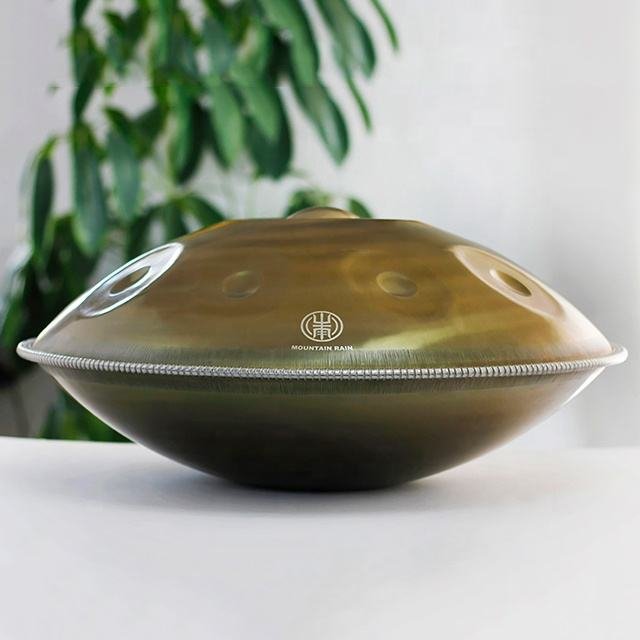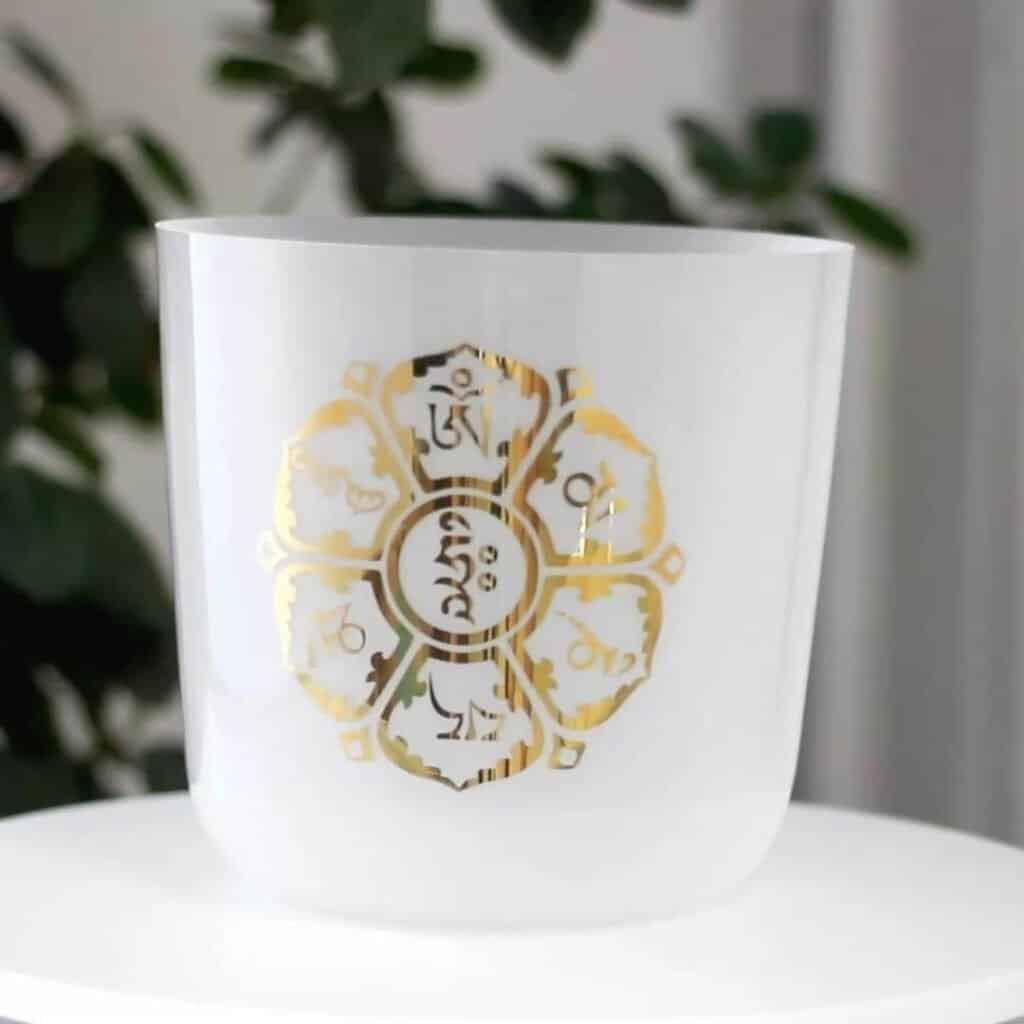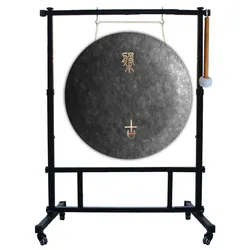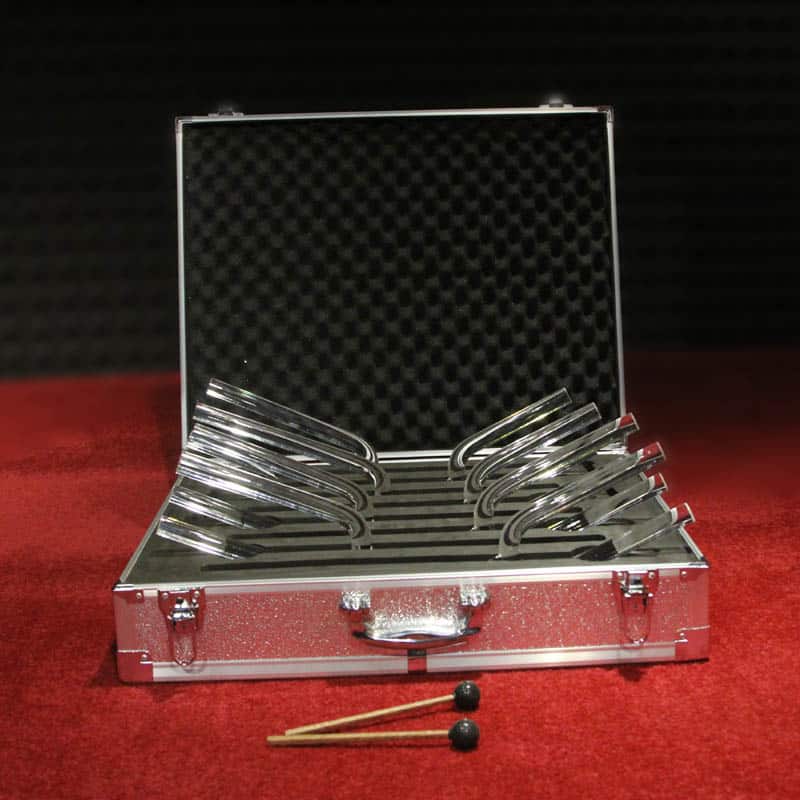You’ve probably encountered moments when your mind feels cluttered and your body tense, searching for a way to find peace in today’s chaotic world. Sound baths offer a unique pathway to tranquility that doesn’t require meditation experience or complex techniques. Through the resonant tones of singing bowls, gongs, and other ancient instruments, you’ll discover a practice that goes beyond traditional relaxation methods. As sound waves wash over you, they’ll guide you into a state of deep calm while revealing benefits that extend far beyond your time on the mat.
Key Takeaways
�?Sound baths are immersive meditation sessions using singing bowls, gongs, and chimes to induce deep relaxation and mental clarity.
�?Sessions typically last 45-90 minutes, during which participants may experience physical sensations, emotional releases, and altered time perception.
�?Sound vibrations influence cellular structure and brainwaves, promoting stress reduction, improved focus, and overall physical well-being.
�?Participants should wear comfortable clothing, arrive early, and set clear intentions before the session for optimal experience.
�?Both group and solo sessions are available, with group sessions offering shared energy benefits and solo sessions providing personalized attention.
What Are Sound Baths
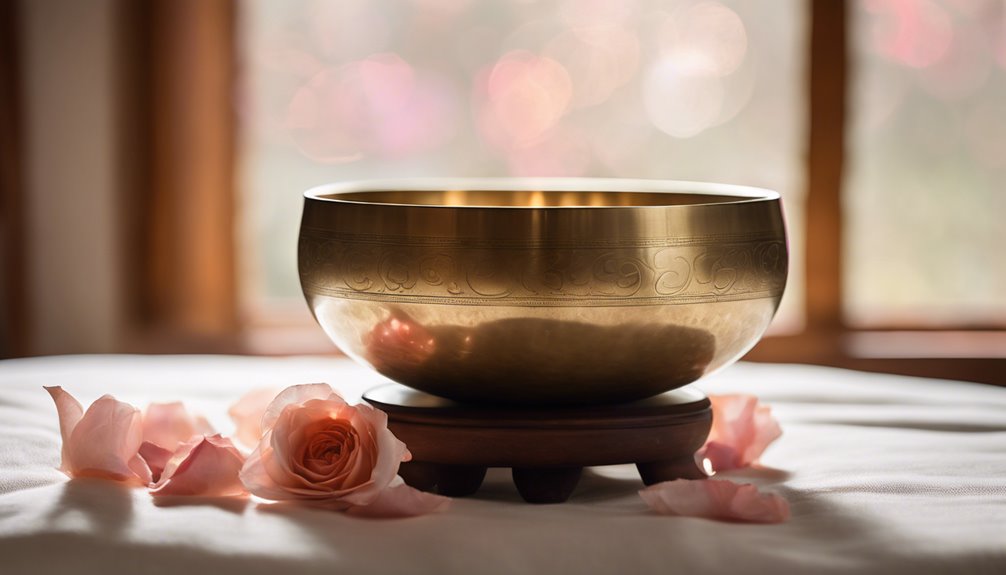
A sound bath is an immersive meditation experience where you’re surrounded by healing vibrations and frequencies produced by various instruments. During these sessions, you’ll hear overlapping waves of sound created by singing bowls, gongs, chimes, and other resonant tools that wash over you like gentle waves, creating a deeply relaxing atmosphere. The sound description often includes terms like ethereal, encompassing, and transformative, as these sonic vibrations penetrate both your body and consciousness.
You’ll typically find yourself lying comfortably on a mat while a skilled practitioner guides you through the experience. The session duration usually ranges from 45 to 90 minutes, giving you ample time to sink into a meditative state as the sounds evolve and blend. Unlike traditional meditation, where you might struggle to quiet your mind, sound baths make it easier to let go of thoughts as you focus on the pure experience of sound. The vibrations work on multiple levels, affecting your brainwaves, nervous system, and energy fields, potentially helping to reduce stress, improve focus, and promote emotional balance.
Ancient Origins and Cultural Significance
You’ll find the roots of sound baths deeply embedded in Eastern philosophical traditions, where ancient practitioners recognized the profound connection between sound vibrations and spiritual well-being. Throughout history, healing practitioners across cultures have used instruments like singing bowls, gongs, and drums to restore balance and promote wellness in both body and spirit. These sacred sound ceremonies have been integral parts of spiritual and medicinal practices in Tibet, India, and other Asian societies for thousands of years, where they’ve been used for everything from chakra alignment to treating physical ailments.
Origins in Eastern Philosophy
Sound baths trace their origins back thousands of years to ancient Eastern spiritual practices, particularly those from Tibet, India, and Nepal. You’ll find that these deeply rooted eastern philosophies emphasize the connection between sound vibrations and spiritual awakening, viewing sound as a pathway to higher consciousness and inner healing.
In these traditional meditative practices, practitioners believed that specific frequencies could align your body’s energy centers, known as chakras, and restore balance to your physical and spiritual being. Tibetan monks, for instance, developed intricate ceremonies using singing bowls, bells, and chants to facilitate deep meditation and spiritual transformation. You’ll discover that many of these ancient techniques incorporated natural harmonics and overtones, which they believed could penetrate the body’s subtle energy field.
When you explore the historical foundations of sound healing, you’ll notice how these Eastern traditions understood that different tones affect various parts of your consciousness. They recognized that sustained sounds could guide you into altered states of awareness, helping you achieve what modern practitioners now call “theta state,” where deep healing and transformation become possible.
Historic Healing Practices
Throughout human history, healing practitioners have wielded sound as a therapeutic tool, with evidence spanning from ancient Egyptian medical papyri to Aboriginal didgeridoo ceremonies. You’ll find that these ancient rituals weren’t simply about making noise – they represented sophisticated holistic therapies that addressed both physical and spiritual wellbeing.
When you explore the historical records, you’ll discover that virtually every major civilization developed its own sound-based healing practices. These techniques have survived through generations of careful preservation and practical application.
| Culture | Instruments Used | Healing Purpose |
|---|---|---|
| Tibetan | Singing Bowls | Stress reduction |
| Native American | Drums, Rattles | Spirit cleansing |
| Ancient Greek | Lyres, Flutes | Mental harmony |
Today’s sound healing practices draw deeply from these time-tested methods, though you’ll find they’ve been adapted to suit modern therapeutic needs. What’s fascinating is how these ancient approaches align with contemporary research on vibration’s effects on human physiology. When you participate in a sound bath, you’re not just experiencing a relaxation technique – you’re connecting with therapeutic traditions that span millennia of human healing wisdom.
Sacred Ceremonial Traditions
These ancient healing practices laid the foundation for deeply meaningful ceremonial traditions that continue to shape modern sound bath experiences. You’ll find that sacred rituals involving sound have been woven into the spiritual fabric of cultures worldwide, from Tibetan monasteries to Native American healing ceremonies, where practitioners have used specific tones and frequencies to facilitate transformation and healing.
When you participate in today’s sound baths, you’re connecting to ceremonial music traditions that span thousands of years. Ancient cultures understood that specific sounds could alter consciousness and facilitate spiritual awakening, which is why they incorporated instruments like singing bowls, drums, and chants into their most sacred ceremonies. These rituals weren’t simply about making pleasing sounds; they were carefully choreographed experiences designed to align participants with divine energies and natural rhythms. Many contemporary sound healers draw from these time-honored practices, combining traditional instruments and methods with modern understanding to create powerful transformative experiences. You’re fundamentally stepping into a living tradition that bridges ancient wisdom with present-day wellness practices, allowing you to experience the same profound effects that generations before you have encountered.
The Science Behind Sound Healing
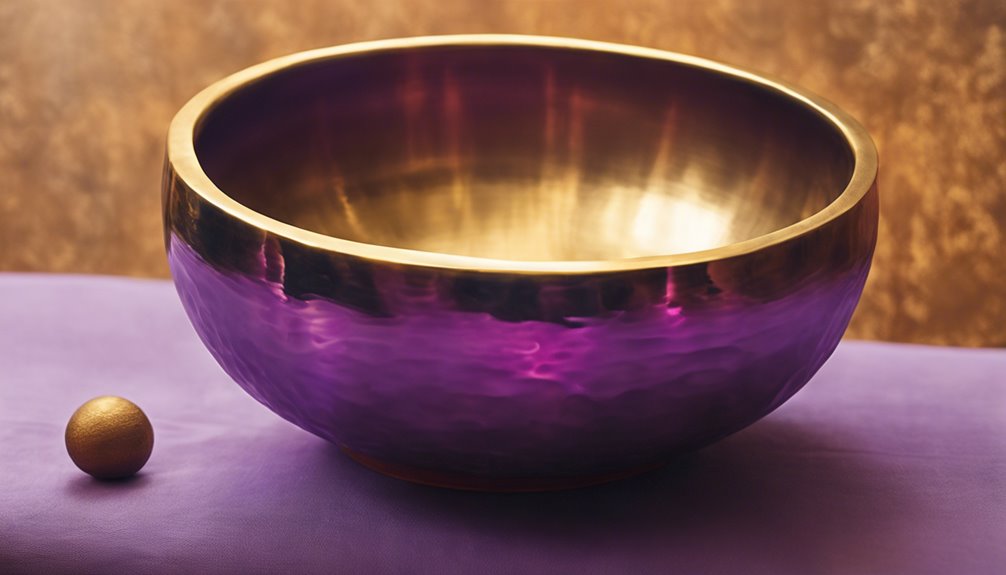
When you experience a sound bath, your brainwaves naturally sync with the frequencies of the singing bowls and gongs through a process scientists call “brainwave entrainment,” which can help shift your mind from an active beta state to a more relaxed alpha or theta state. You’ll find that sound’s effects go far beyond your brain, as research shows that sound vibrations can influence your body at a cellular level, causing changes in cell membranes and metabolic processes. The vibrations from therapeutic sound instruments create specific frequencies that interact with your body’s water content and cellular structure, potentially promoting healing and reducing inflammation throughout your system.
Brainwave Entrainment and Healing
Scientists have discovered that sound frequencies can directly influence our brainwave patterns through a process called brainwave entrainment. When you’re exposed to specific healing frequencies, your brain naturally begins to synchronize with these sounds, shifting your consciousness into different states of awareness. This remarkable process allows you to experience deeper levels of relaxation and heightened focus.
During a sound bath session, you’ll notice how your brainwave patterns gradually align with the frequencies being played. As singing bowls, gongs, and other instruments produce their therapeutic tones, your brain will shift from its normal beta state into more peaceful alpha and theta states. These slower brainwave patterns are associated with meditation, creativity, and deep healing. You’ll find that your body responds by releasing tension, lowering blood pressure, and reducing stress hormones. The entrainment process works because your brain’s natural tendency is to match external rhythms, much like how you’ll unconsciously sync your footsteps with a steady drumbeat. This neurological phenomenon explains why sound baths can be so effective at promoting both physical and emotional well-being.
Sound Vibrations Affect Cells
The impact of sound vibrations extends far beyond brainwave patterns, reaching deep into the cellular structure of your body. When you’re exposed to specific sound frequencies, your cells respond through vibrational resonance, creating a ripple effect throughout your tissues and organs. This cellular response isn’t just theoretical – scientists have observed how sound waves can influence cellular metabolism and even promote healing at the microscopic level.
You’ll find that sound vibrations affect your body’s cells in fascinating ways, as each cell membrane vibrates in response to acoustic energy. This process, known as cellular healing, occurs when sound frequencies match your body’s natural resonant frequencies, encouraging ideal cellular function and repair. Your cells can absorb and transmit these therapeutic vibrations, which may help reduce inflammation and support your body’s natural healing mechanisms.
When you experience a sound bath, you’re not just hearing pleasant tones – you’re allowing sound waves to interact with every cell in your body, potentially promoting balance and regeneration at the most fundamental biological level. This cellular response helps explain why many people report feeling refreshed and renewed after sound therapy sessions.
Essential Sound Bath Instruments
Traditional sound bath practitioners commonly rely on a core set of powerful instruments to create healing vibrations and resonant frequencies. You’ll often find crystal bowls, which produce pure, sustained tones that can resonate with your body’s energy centers, while precisely calibrated tuning forks deliver focused vibrations that target specific areas for healing and balance.
Among the most revered instruments, you’ll discover Tibetan singing bowls, which create rich, multilayered harmonics that wash over you like waves of sound. Gongs, particularly symphonic and planetary gongs, generate complex overtones that you’ll feel deeply penetrating your body’s tissues. You might also experience the ethereal sounds of wind chimes, rain sticks, and ocean drums, which add texture and movement to the sonic landscape.
Many practitioners incorporate the human voice through overtone chanting or humming, which can help you connect more deeply with the experience. You’ll notice that each instrument serves a specific purpose in the sound healing journey, working together to create an all-encompassing therapeutic environment that supports your body’s natural healing processes.
Preparing for Your Session
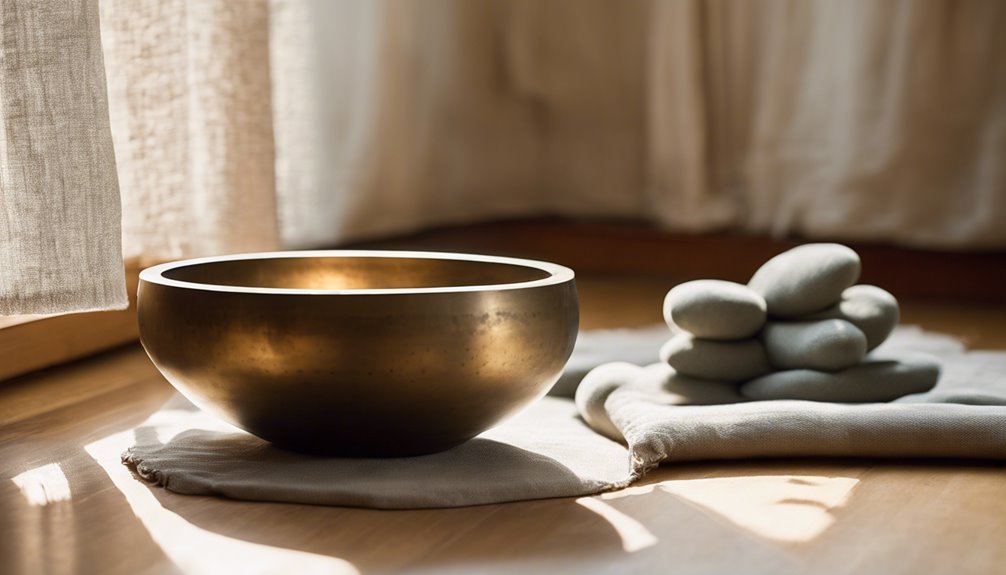
Preparing for your sound bath experience requires thoughtful consideration to maximize its benefits. You’ll want to arrive at least 15 minutes early to settle into the space and begin focusing on breath awareness. Wear loose, comfortable clothing that won’t restrict your movement or distract from your meditation. Before the session begins, take time for intention setting, clearly defining what you hope to achieve during your sound journey.
| Do’s | Don’ts |
|---|---|
| Eat lightly 2 hours before | Arrive rushed or stressed |
| Bring a yoga mat and blanket | Wear noisy jewelry |
| Stay hydrated beforehand | Use electronic devices |
| Practice basic meditation | Eat heavy meals prior |
| Communicate health concerns | Force specific outcomes |
Position yourself comfortably, either lying down or seated, ensuring you’re warm enough as body temperature often drops during deep relaxation. You’ll want to remove any accessories that might create unwanted sounds or physical distractions. If you’re new to sound baths, consider arriving even earlier to discuss any concerns with your practitioner and familiarize yourself with the space. Remember, the more prepared you are, the deeper your meditative experience can be.
Finding the Right Practitioner
Selecting a sound-healing practitioner requires careful consideration and research to guarantee you’ll receive an authentic, transformative experience. When searching for the right guide, you’ll want to examine their practitioner credentials, including formal training in sound therapy, certifications from recognized institutions, and their experience working with various healing instruments.
Start by reviewing potential practitioners’ websites and social media presence to understand their approach and philosophy. You’ll find that personal compatibility plays an essential role in your sound bath experience, so don’t hesitate to schedule a brief consultation before committing to a session. During this meeting, ask about their specific training, the instruments they use, and their therapeutic methods. Pay attention to how they communicate and whether their energy aligns with your goals.
Consider asking for references from past clients or reading reviews from their regular students. A qualified practitioner should be able to explain the scientific principles behind sound healing while maintaining a grounded, professional approach. They should also demonstrate knowledge about contraindications and safety protocols, ensuring you’ll receive appropriate care during your sound healing journey.
Benefits for Mind and Body
You’ll find that sound baths offer powerful ways to release stress and recover from life’s daily challenges, as the resonant frequencies help your body and mind shift into a more balanced state. The vibrations from singing bowls, gongs, and other instruments work directly with your nervous system, creating a natural pathway to relaxation and renewal that you can’t achieve through ordinary rest alone. Your mental clarity will improve as the sonic waves help clear away mental fog and emotional blockages, letting you experience a sharper, more focused state of mind.
Stress Relief and Recovery
While modern life bombards us with constant stressors, sound baths offer a powerful path to mental and physical recovery. Through carefully orchestrated frequencies and vibrations, these sessions create an environment where your body can activate its natural stress management responses. You’ll find that sound therapy works synergistically with your nervous system, promoting deep relaxation and cellular recovery techniques that help restore balance to both mind and body.
Here’s what you can expect during a sound bath session for stress relief:
- Your heart rate and blood pressure naturally begin to lower within the first 10 minutes
- Stress hormones like cortisol decrease as healing alpha brain waves increase
- Muscle tension melts away as sound frequencies penetrate deep into tissue
- Your breathing naturally synchronizes with the rhythmic sounds, promoting oxygen flow
When you’re immersed in these therapeutic soundscapes, you’ll experience a profound sense of calm that continues well after your session ends. The cumulative effects of regular sound baths can strengthen your resilience to daily stressors and enhance your body’s natural recovery processes, making this practice an invaluable tool in your wellness journey.
Enhanced Mental Clarity
Like a gentle morning fog lifting to reveal pristine clarity, sound baths can dramatically enhance your mental acuity and cognitive function. Through the combination of mindful breathing and intuitive listening, you’ll discover that sound frequencies help clear away mental clutter and sharpen your focus. As you immerse yourself in the resonant tones, your brain begins to synchronize with these healing vibrations, creating an ideal state for clear thinking and enhanced awareness.
During a sound bath session, you’ll notice how your scattered thoughts begin to organize themselves naturally, making room for deeper insights and creative solutions. The harmonic overtones produced by singing bowls, gongs, and other instruments activate your brain’s neural pathways, improving your ability to process information and make decisions. You’ll find yourself better equipped to tackle complex problems as the sound waves help stimulate both hemispheres of your brain, fostering improved cognitive performance and mental stamina. This heightened state of clarity often persists long after your session ends, allowing you to approach your daily tasks with renewed focus and enhanced mental precision.
Sound Bath Etiquette
Proper etiquette during a sound bath guarantees everyone can fully experience the meditative benefits. When you’re preparing for your session, choose comfortable sound bath attire that won’t make noise when you move, such as soft cotton clothing or stretchy activewear. Most sound bath duration ranges from 45 to 90 minutes, so you’ll want to make sure you’re dressed appropriately for extended periods of lying still.
Here are essential guidelines to follow during your sound bath experience:
- Arrive at least 10 minutes early to settle in and choose your spot without disrupting others
- Turn off your phone completely – don’t just set it to vibrate
- Remain still throughout the session, even if you feel the urge to stretch or shift positions
- Exit quietly after the session ends, allowing others to maintain their peaceful state
Remember to respect the sacred space by refraining from talking during the experience. If you need to leave early, position yourself near the exit beforehand and depart as quietly as possible. Your considerate behavior helps create an ideal environment for everyone’s healing journey.
Creating Space for Practice
Setting up a dedicated space for sound bath practice can transform your meditation experience. When you create a meditative space, you’ll want to choose a quiet area in your home where you won’t be disturbed by external noise or interruptions. Consider using soft lighting, comfortable cushions, and natural elements like plants or crystals to enhance the ambient environment.
You’ll need enough room to lie down comfortably with your sound healing instruments positioned around you. If you’re working with singing bowls, arrange them within arm’s reach so you can play them while maintaining a relaxed position. Proper ventilation is essential, but you should avoid areas with strong drafts that might interfere with the sound vibrations.
To further optimize your space, you might want to incorporate elements that engage your other senses. A gentle essential oil diffuser can add aromatherapy benefits, while soft fabrics like blankets and pillows can provide comfort during your practice. Remember to keep your space clutter-free and dedicated solely to your sound healing sessions, as this will help you maintain the sacred nature of your practice.
Common Sound Bath Experiences
Once you’ve created your ideal meditation space, you’ll discover that sound bath experiences can vary greatly from person to person. Participant feedback reveals a remarkable sensation diversity, with each individual connecting to the vibrations and frequencies in uniquely personal ways. You’ll find that your own experience might shift from session to session, depending on your emotional state and receptiveness to the sounds.
Here’s what you might experience during a sound bath session:
- Physical sensations like tingling in your limbs, warmth spreading through your body, or a feeling of floating
- Emotional releases that can manifest as tears, spontaneous laughter, or a deep sense of peace
- Visual experiences, even with closed eyes, such as seeing colors, patterns, or peaceful imagery
- Time distortion, where minutes can feel like hours or vice versa
As you progress in your practice, you’ll notice that these experiences become more refined and meaningful. Your body will learn to recognize and respond to specific frequencies, creating deeper states of relaxation and meditation with each session. Don’t be surprised if you discover new sensations that weren’t present in previous sessions.
Deepening Your Sound Journey
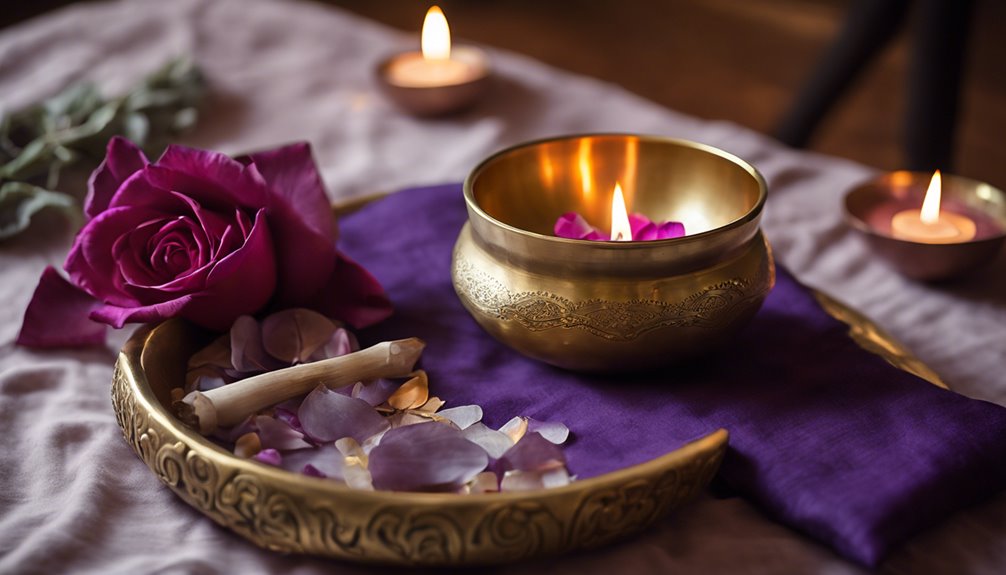
The journey into sound meditation becomes more profound as you develop your practice and understanding of its nuances. As you explore the layers of resonant frequencies, you’ll discover that each session can take you deeper into states of relaxation and awareness. You’ll learn to distinguish subtle variations in tones and identify how different sounds affect your physical and emotional responses.
To enhance your experience, focus on intensifying resonance by positioning yourself where the sound waves feel most impactful. You’ll notice how exploring frequencies at various distances from the instruments creates unique sensations throughout your body. Try experimenting with different postures and breathing patterns while maintaining awareness of how the vibrations interact with your energy centers.
As your practice deepens, you might find yourself naturally drawn to specific tones or instruments. Trust this intuitive connection, but don’t limit yourself to familiar sounds. Each session offers an opportunity to discover new dimensions of the sound experience. Remember to stay present with the waves of sound as they wash over you, allowing the harmonics to guide you into progressively deeper states of meditation.
At-Home Sound Bath Tips
Creating your own sound bath sanctuary at home opens up daily opportunities for meditative practice. With proper at-home preparation, you’ll transform any space into a peaceful retreat where healing vibrations can wash over you. The key is establishing the right environment and gathering your sound bath essentials before beginning your practice.
- Set up your space by removing distractions, dimming lights, and laying out comfortable cushions or a yoga mat
- Collect your instruments: singing bowls, chimes, drums, or even quality recorded sounds through a reliable speaker system
- Prepare aromatherapy elements like essential oils or incense to enhance the sensory experience
- Establish a dedicated time when you won’t be interrupted, ideally 30-45 minutes
You’ll want to position yourself in a way that allows sound waves to flow freely around you. Consider incorporating crystals or meaningful objects that resonate with your practice. Remember, your at-home sound bath doesn’t need to replicate a professional session exactly – it’s about creating a consistent, peaceful routine that works for your lifestyle and supports your meditation journey.
Group Versus Solo Sessions

When deciding between group and solo sound bath sessions, practitioners should weigh the unique benefits each format delivers. Group sessions harness the power of collective energy and group dynamics, creating a shared experience that can amplify the healing vibrations. You’ll often find that the communal atmosphere enhances your practice through the synchronized breathing and unified intention of participants.
Solo sessions, however, offer deeper personal reflection and customization. You’re free to fully immerse yourself without external distractions, allowing for a more intimate connection with the sound frequencies. During private sessions, you can communicate your specific needs to the practitioner, who’ll tailor the experience accordingly.
| Format | Benefits | Considerations | Best For |
|---|---|---|---|
| Group Sessions | Shared energy, community support | Less individual attention | Social practitioners |
| Solo Sessions | Personalized experience, focused healing | Higher cost | Deep inner work |
| Virtual Group | Convenience, accessibility | Limited energetic connection | Remote participants |
| Private Virtual | One-on-one guidance, flexibility | Technology dependence | Busy schedules |
You’ll need to evaluate your personal goals, comfort level with others, and desired outcomes when choosing between these formats.
Conclusion
While you might think sound baths are just another wellness trend that’ll fade away, you’ll find it ironic that this ancient practice has become more relevant in today’s chaotic world than ever before. As you’ve discovered, these therapeutic sound sessions aren’t simply about listening to pretty sounds – they’re about experiencing a profound shift in consciousness that’ll help you navigate life’s challenges with greater clarity and purpose.


